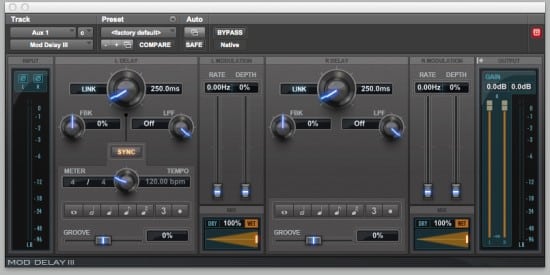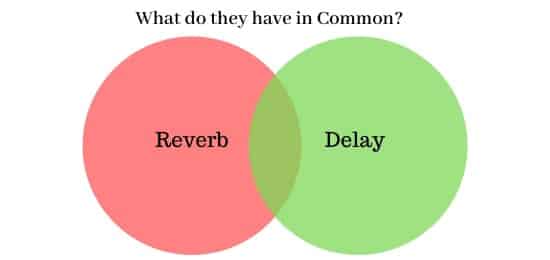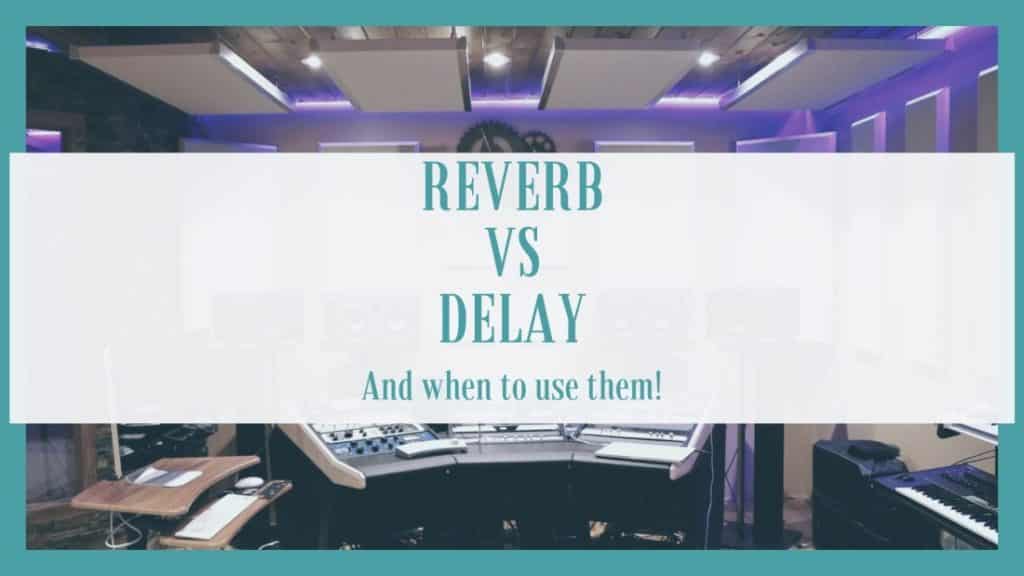Last updated on February 21st, 2022 at 08:46 am
Anyone who is new to audio engineering has probably asked this question at some point.
Reverb and delay are two of the effects that are probably used to the most when producing any kind of music, and you should know exactly what each of them does and also when to use them, since this can be even more confusing.
In this post I will go over what each of these effects does, what the differences are, their similarities and when to use them.
Let’s start with the Basic Differences between the two;
What are the differences between Reverb and Delay?
Both are time-based sound effects but delay is the repetition of the signal after a brief period of time, and the number of repetitions depend on the feedback setting, whereas reverb gives your sound an atmospheric feel and it’s s what we perceive as the room’s acoustics.
Let’s take a closer look at how delay works.
What is a Delay?

A delay is nothing more than the same original audio signal being repeated again and again after a short period of time.
The number of times the signal is repeated is called feedback.
This means that the more feedback, the more the signal will be repeated and the effect will carry on for longer.
Different Types of Delay
Delays can be broadly categorized as Short and Long.
Short delay
Short delays are usually classified into Doubling Delays and Slapback Delays;
Doubling Delay: The delay happens 20ms-40ms after the original sound.
Slapback Delay: Usually around 75ms-250ms after the original audio.
Long Delay
A long delay a high feedback, which means that it gets repeated many times.
Example: Brighton Rock solo, by Brian May, Queen.
What is a Reverb?

Reverb is something we interact with each and every day.
It’s when the soundwaves bounce off every surrounding surface and then reach our ears at slightly different times.
This gives us the perception of space when hearing.
Reverb can also be viewed as a lot of differently timed delays with different feedbacks which sort of “blur” together, giving the perception of space and depth.
5 Different Reverb Types
There are basically 5 different types of reverb; Room, Hall, Chamber, Plate and Spring.
The Room Reverb is just that; It sounds like a room and the decay time is very short.
The Hall Reverb emulates how Concert Halls sound, which are designed to sound as tonally even and perfect as possible.
The chamber Reverb sounds like a large room typically designed for orchestras but isn’t as large as the Hall one.
The plate and spring reverbs are man made and use a metal plate or a spring that vibrate and create the reverb.
When Should you use Reverb or Delay?
This is a complicated question with no right answer since it depends entirely on the genre and the song you’re producing and also on how YOU want it to sound.
But there is one rule that you should always follow when adding any of these two effects;
Be Subtle when adding Reverb and Delay
Subtlety is king when adding reverb and delay.
You usually want them to create the feeling of space and depth, which means that you should be able to notice when these effects are there, or when they aren’t, but they shouldn’t be overpowering.
If you feel like you can hear them too much, or if they distract the listener from what’s really going on in the song, just dial it down.
This is by far the most common mistakes beginners make and it’s a tough balance to achieve.
Use Reverb when you have a specific space in mind!
Reverb is designed to create a sense of space and to emulate the sound of a specific room, hall, etc.
It helps you put the sound in a familiar space, giving the song context.
Of course, it can be used to create a completely different and unfamiliar space, but it gives the listener context for the song.
Examples: Do you want to recreate the sound of a concert hall, industrial space, regular room, maybe even the illusion of being underwater?
This is where reverb can help.
Use Reverb for Consistency in the Mix
Reverb is used to draw the listener into the environment that you want the song to be in.
If you use a multitude of reverbs, you will also create a lot of different spaces, and this might be confusing to the listener.
Exercising caution and restraint here is key; Use only similar types of reverb for the song, like only Room reverbs for one song, hall reverbs for another, and so on.
In general, don’t mix the different reverb types.
Use Reverb in Slow and Open Songs
Fast and upbeat music doesn’t go that well with reverb since it might make things muddy.
Slow songs that have few elements competing in the mix, like a slow acoustic guitar-, piano and vocals song, are perfect for reverbs since you can use ones with very long tails and let them decay naturally.
Use Delay in fast-paced and rhythmic songs
Delays can be used to add rhythm to a song my syncing the delay time to the tempo of the song and adjusting the dry and wet ratio.
It can be used to enhance grooves or to even create new grooves out of static elements in the mix.
But if you reach for a reverb in this kind of music, more often than not it will make everything sound distant and muddy.
Use a Delay if the mix sounds Muddy
If you start adding reverb to most elements in the mix, you might notice that suddenly the guitar fades into the background, some other instruments don’t cut well through the mix, and everything gets muddy.
Try using delay instead on some of those tracks and hear your mix clean up.
What do Delay and Reverb have in Common?

Both of them are time-based effects which process the signal altering it in different ways, even though they may be very closely related, they are not the same at all.
Flanging, Chorus and Reverb are all delay-based Effects actually, but with Flanging and Chorus, the delay time is short and, in many cases, modulated.
When it comes to reverb there are multiple delays and feedback which make the “echoes” blur together, making it sound like an acoustic space.
A Reverb would be, in some sense, a lot of different simultaneous delays which end up recreating a room or any other acoustic space.
Conclusion
Learning how and when to use each of these effects is something that can only be achieved through practice and repetition.
However, I hope I was able to give you some pointers on when and how to use them, at least to make the whole learning process faster and avoid some headaches along the way.
I hope you have a wonderful day!
Until the next one!

Probably the best explanation of reverb and delay anywhere online. Thanks!
Hey! Thanks for that great text! // Olof from Sweden
Thanks for all you know about reverb n delay, we hope can get chance to use them playing and hear some music om a small party.
Thank you !
Just wondering about the use of BPM to set the delay time so it blends better with the song and doesn’t stand out?